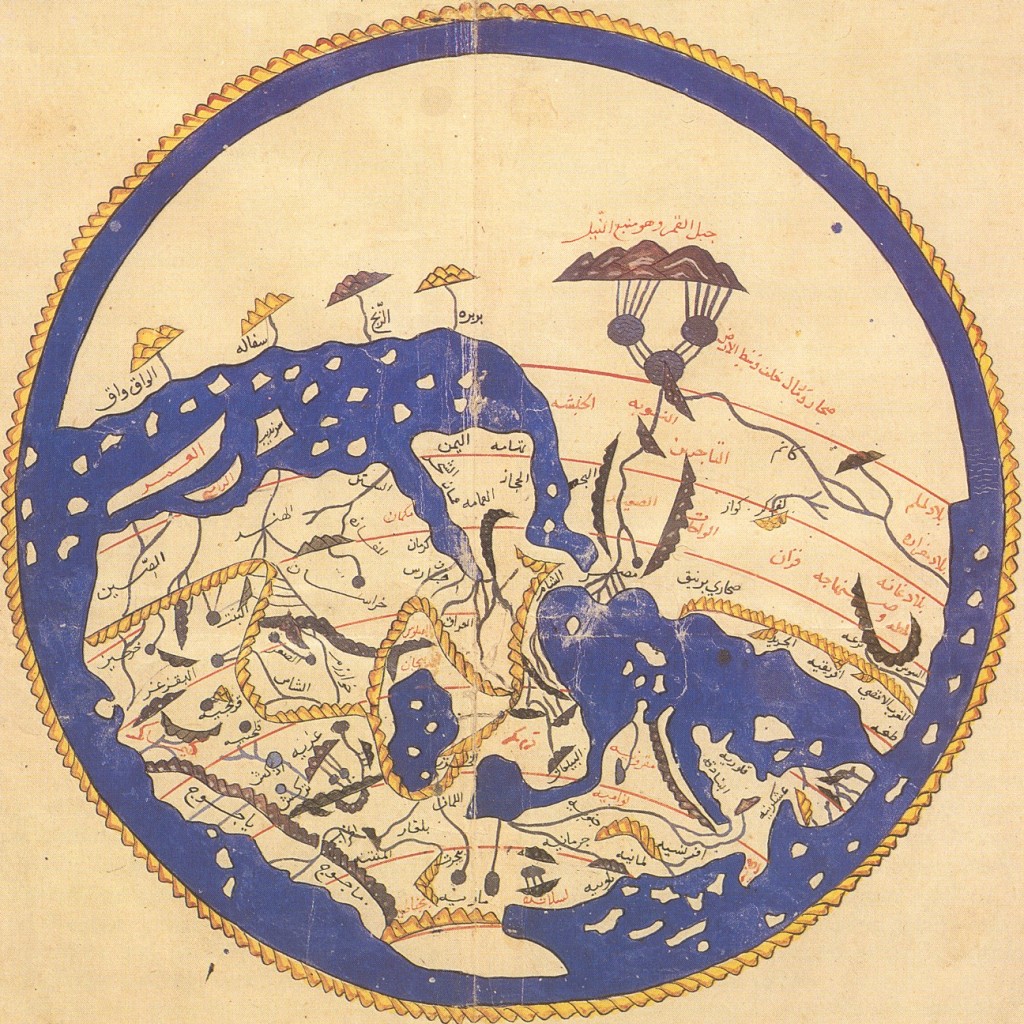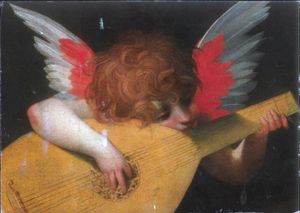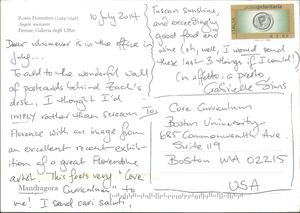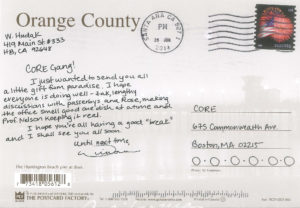July 19, 2014 at 9:47 am

A map dating from 1154 CE by Moroccan cartographer al Idrisi for King Roger of Sicily. South is oriented at the top of the page, placing Europe in the lower half of the page.
Perhaps you’ve seen McArthur’s Universal Corrective Map of the World where the southern hemisphere appears on the top and the northern below. In the western world, the vision of a world map where the north is at the top with the Americas on the left and Eurasia to the right seems unquestionable. However, as a recent article on Aljazeera America points out, this convention is relatively new. For instance, the Egyptians placed south at the top and, for quite a while in Middle Ages, European cartographers placed east at the top of the page. So how did the north end up at the top of the page? Some theorize that the compass influenced this choice while others argue that a Eurocentric bias is at the route. However, there are issues with both ideas and it was likely a mixture of influences that contributed to our modern north-on-top maps.
By vpriest
|
Posted in Uncategorized
|
July 15, 2014 at 11:34 am

We were delighted to hear back from Professor Gabrielle Sims this week in the form of a postcard to the Core office. She writes to us from her beloved Italy and wishes us well. Take a look at what she has to say:

10 July 2014
Dear whomever is in the office in July...
To add to the wonderful wall of postcards behind Zak's desk, I thought I'd IMPLY rather than scream Florence with an image from an excellent recent exhibition of a great Florentine artist. This feels very "Core Curriculum" to me! I send cari saluti, Tuscan sunshine, and exceedingly good food and wine (oh, well, I would send these last 3 things if I could!)
Con affetto, a presto,
Gabrielle Sims
* Core loves postcards. Whether youre at home or abroad now, wed love to get one from you. Our address is easy: Core Curriculum, Boston University, Boston MA 02215.
By cdossett
|
Posted in Postcards
|
Tagged Florence, gabrielle sims, postcard
|
July 3, 2014 at 7:59 am
A humorous post recently appeared on Mashable which shared medieval drawings of animals which look nothing like reality. These hilarious works of art are fun to laugh at, but they also get us thinking about the artists behind them.

From the Rochester Beastiary
Look at the drawing of the elephant, for instance. While a certain amount of skill is evident in the techniques used by the painters, we know that even a young child today could give us a better representation of an elephant than the medieval artist who was likely actually highly trained in illumination and/or painting. This is a testament to the power of photography. Accurate images of elephants are readily available to everyone, while the medieval artist had likely only had one described to them by someone else who had it described to them in turn, and so on. Imagine drawing a creature you have never seen and cannot even be certain exists. In this instance, the artist was likely told that an elephant has a long nose like a funnel, thick legs, large fan-like ears, tusks like a boar and a tail like a horse. It would have been up to the artist to put this all together and fill in the blanks to give the largest land animal an image.

From Imgur
This oyster looks nothing like the pearl-presenting bivalves we are familiar with.

From Wikipedia Commons Peter Isotalo, origionally Livre des Simples Médecines
It appears that the artist was told a beaver is like a weasel with a fish tale. If beavers look like this, then creatures like griffins don't seem all that far-fetched.
In short, these drawings show us the power of photography and our globalized world while giving us a glimpse of what it might have been like to live in a world where one had to rely on the spoken word far more than we are used to.
To see the rest of these ridiculous drawings, see the original post on Mashable: 14 Creepy Medieval Beasts That Look Nothing Like Real Animals.
By vpriest
|
Posted in Uncategorized
|
June 30, 2014 at 11:01 am
 The term "liberal arts" comes up a lot when discussing the various approaches to education found at American colleges and universities, but what exactly is a liberal arts education? Michael S. Roth's new book, "Beyond the University: Why Liberal Education Matters" tries to define it.
The term "liberal arts" comes up a lot when discussing the various approaches to education found at American colleges and universities, but what exactly is a liberal arts education? Michael S. Roth's new book, "Beyond the University: Why Liberal Education Matters" tries to define it.
Roth argues that two distinct liberal arts traditions can be observed in the history of American tertiary education:
The first is a philosophical tradition emphasizing preparation for inquiry; its aim is freeing the mind to investigate the truth about things physical, intellectual and spiritual. The second is a rhetorical tradition emphasizing initiation into a common culture through the study of canonical works; its aim is learning to participate in the culture, to appreciate its monuments and to create new monuments inspired by the old. Roth characterizes the philosophical thread as “skeptical” and the rhetorical thread as “reverential.”
In most cases, universities or colleges define a liberal arts education as some combination of these two strands, emphasizing one or the other, in an effort at "serving the needs of the 'whole person'".
Roth's discussion of a liberal arts education does not end here though. He goes on to critique the two-fold American liberal arts education and the idea that it must "higher education must generate useful knowledge that can benefit society, or can increase the student’s financial and social status, or can advance business and economic interests", showing how influential Americans have helped to form the country's educational system. Individuals discussed include Thomas Jefferson, who "admired knowledge for its own sake but insisted that it also be useful to human progress"; Ralph Waldo Emerson, who believed that "education demanded cultivation of the self, resistance to the crowd and striving to transform society"; Booker T. Washington, who saw education as a means of "economic inclusion that might eventually lead to higher pursuits" for minorities such as the African-American community; W.E.B. Du Bois, who went further and asserted that education provided one with the ability to "help others attain their own freedom"; Jane Addams, who pursued education as a means to "cultivate empathy and cooperation"; and William James, who saw education in literature as a way to develop the imagination and "help overcome blindness to others’ points of view".
Ultimately, Roth believes that education should go beyond the confines of university corridors towards the growth of the whole individual for the entirety of life. "Now more than ever, we need both reflective and pragmatic liberal education if we are to shape accelerating change rather than be shaped by it."
The original article discussing Roth's book can be found on The Washington Post. Another take on the same article can be found on The Daily Beast.
By vpriest
|
Posted in Uncategorized
|
June 29, 2014 at 4:54 pm

We got mail! Today's postcard comes to us from Core alum and office staffer Winona Hudak,who writes to us from Dante's Paradise. Or something like that. Read what she has to say:

Core Gang!
I just wanted to send you all a little gift from paradise. I hope everyone is doing well--Zak, lengthy discussions with passerbys and Rose, making the office smell good one dish at a time and Prof. Nelson keeping it real.
I hope you're all having a good "break" and I shall see you all soon.
Until next time,
Winona
* Corelovespostcards. Whether youre at home or abroad now, wed love to get one from you. Our address is easy: Core Curriculum, Boston University, Boston MA 02215.
By cdossett
|
Posted in Postcards
|
Tagged postcard
|
June 27, 2014 at 1:59 pm
 Congratulations to Professor David Swartz for winning the History of Sociology Section Distinguished Scholarly Publication Award from the American Sociological Association for his book Symbolic Power, Politics, and Intellectuals: The Political Sociology of Pierre Bourdieu. Professor Swartz teaches in the Department of Sociology and the Core Curriculum Social Sciences. His book, which can be purchased from the University of Chicago Press, argues that power and politics are central to understanding Bourdieu's sociology and that sociology is not only a science but a "crucial form of political engagement".
Congratulations to Professor David Swartz for winning the History of Sociology Section Distinguished Scholarly Publication Award from the American Sociological Association for his book Symbolic Power, Politics, and Intellectuals: The Political Sociology of Pierre Bourdieu. Professor Swartz teaches in the Department of Sociology and the Core Curriculum Social Sciences. His book, which can be purchased from the University of Chicago Press, argues that power and politics are central to understanding Bourdieu's sociology and that sociology is not only a science but a "crucial form of political engagement".
By vpriest
|
Posted in Uncategorized
|
June 18, 2014 at 3:13 pm

The Core recently did a survey of syllabi in programs at other schools offering courses that are like Core in method and structure: primary texts, organized chronologically, giving students a working knowledge of the foundational works and ideas of our shared cultural heritage. While many of the books we saw on those other syllabi were familiar to us -- Gilgamesh! The Aeneid! The Confessions! Pride & Prejudice! -- we were intrigued by the range of readings that aren't studied in our own classes, but which we could imagine falling into place on our reading list if there were only room enough.
Below, we've compiled a list of some of the major works students in other Core programs are reading. Some of them you'll likely have heard of; others are less commonly encountered, inside the classroom or outside of it. In any case, we here in the Core office think a case could be made for including any or all of these books in a Core-type course. But then, we here in the Core office also think a case could be made for establishing Core-type courses for students in the third year, and the fourth year, and, why not, as continuing education courses that alumni can take on campus or via some kind of online connection. Ὁ βίος βραχύς! If there is an emblem for our bookworm affliction, it would have to be poor tragic Henry Bemis from that old episode of The Twilight Zone....
Read More »
By zakbos
|
Posted in Uncategorized
|
Tagged books, canon, reading
|
June 9, 2014 at 8:25 pm
The recent LEGO film shows that these popular construction toys are still thriving after more than half a century. Dante's Divine Comedy has thrived for nearly seven centuries. Romanian LEGO artist Mihai Marius Mihu celebrates both by constructing scenes from each level of the Inferno. Here we share some of our favorites!



The rest can be viewed here. Which ones are your favorites? Let us know in a comment below!
Thanks to this article for showing us these marvelous creations!
By vpriest
|
Posted in Art
|
Tagged dante
|
May 28, 2014 at 2:46 pm
Summer's in full swing, and we've all settled into our lazy summer habits, which include the constant struggle trying to keep warm for those of us staying in Boston. For those of you missing the Core office, don't worry, we miss all of you too. To keep your spirits up, we found this wonderful comedic article from Timothy McSweeney's Internet Tendencies. Who ever could have though Socrates' logic could be applied to home cleaning products? Here's an excerpt:
SOCRATES: Tell me, Glaucon, what does “clean” mean?
GLAUCON: Why, it means the opposite of dirty, Socrates.
SOCRATES: Surely it must mean something more than that.
GLAUCON: I don’t understand, Socrates.
SOCRATES: If “clean” means the opposite of “dirty,” then to clean is to rid a space of dirt or plague, yes?
GLAUCON: Yes, Socrates.
SOCRATES: So cleanliness is the complete obliteration of dirt, bacteria and unsightly stains. Am I right?
GLAUCON: Yes, Socrates.
SOCRATES: So to effectively clean, one must also sterilize, as a sterile surface is one that is also not dirty?
GLAUCON: Yes, Socrates.
The humor just keeps coming. Perhaps we, at Core, miss all the reading that takes us through the year so gracefully(even though the summer course is in full swing for the first time ever); perhaps we just couldn't get enough of The Republic. Regardless, enjoy this Wacky Wednesday post and don't forget to send us your selfies reading Core books!
By fegoss01
|
Posted in Core Authors, Great Personalities, Marginalia, Other Publications
|
Tagged books, CC101, humor, Plato, Socrates
|
May 28, 2014 at 1:31 pm

According to a recent article published in the NYTimes, student governments at several major American universities are calling for trigger warnings for rape, violence and other sensitive material to be placed on syllabi, forewarning students who may be upset by such depictions in the literature and media read and discussed in class. And they aren't talking about The Girl With the Dragon Tattoo. Works proposed for trigger warnings include popular tenants of the western literary canon such as The Great Gatsby, Shakespeare and ancient Greek myths. The concept of trigger warnings, rooted in feminist thought, has gained traction on social media sites. Students in favor of adapting the idea for the classroom argue that it would provide "explicit alerts that the material they are about to read or see in a classroom might upset them or, as some students assert, cause symptoms of post-traumatic stress disorder in victims of rape or in war veterans".
However, many professors find the movement ludicrous, arguing that trigger warnings "suggest a certain fragility of mind that higher learning is meant to challenge, not embrace". Lisa Hajjar, a sociology professor at University of California, Santa Barbara, even suggests that the idea is detrimental to academic freedom. Hajjar, who believes that the graphic depictions of torture she uses in her courses about war are essential, says, "Any student can request some sort of individual accommodation, but to say we need some kind of one-size-fits-all approach is totally wrong. The presumption there is that students should not be forced to deal with something that makes them uncomfortable is absurd or even dangerous.”
Let us know how you feel about the debate!
By vpriest
|
Posted in Uncategorized
|















